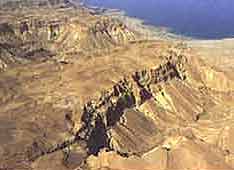|
"Jerusalem's Leading Christian Newspaper"

"New Discoveries of the Bible, Jesus and the
First Church"
Volume 10 --- Internet Edition -- Current Issue --- Issue 8
쿰란의 현자들은 주전 1세기에
오실 그리스도를 예언하였다.
Qumran Sages Prophesied Christ Coming
in the 1st Century BC
"그분의 거룩하신 구세주는 더디 오시지 않을 것이다. . . 그 때 그분은 병든
자들을 고치실 것이고, 죽은 자들을 살릴 것이며, 온유한 자들에게 기쁨의
소식을 선포할 것이다. . ."
"His Holy Savior will not be slow [in
coming)... then He will heal the sick,
resurrect the dead, and to the meek announce glad tidings..."
Ken Russon
Review Staff Reporter
 쿰란동굴들이 숨겨진 유대광야의
산악사막지역
쿰란동굴들이 숨겨진 유대광야의
산악사막지역
An aerial view of the wilderness of the Judean mauntainous desert, where
the caves of Qumran are hidden
|
이스라엘 예루살렘
- "우리 주와 구세주, 예수 그리스도" - "주와 구세주"라는
말은 복음서 저자들에게 정말 무엇을 의미하였는가? 그리고 왜 그가
"그리스도"라고 불리는가?
Jerusalem, Israel -
"Our Lord and Savior, Jesus Christ!" - What did the words "Lord and
Savior" really mean to the writers of the Gospels? And why is He called "The
Christ"?
아주 최근에 해석되어 출판된 사해문서의 한
자그마한 조각은 "기쁜 소식"을 선포한다. 그것은 "[그분의]
거룩하신 [구세주는] 더디 [오시지] 않을 것이기. . ."(10열) 때문에
"메시아의 징조들"이 가까이 있다는 것을 분명하게 진술한다.
A tiny fragment from the Dead Sea Scrolls, which only recently has been
interpreted and published, proclaims "the glad tidings". It clearly states
that the "signs of the Messiah" are near because: "[His] Holy [Messiah] will
not be slow [in coming]...". (line 10)
그 오래된 양피지는 쿰란 공동체의 구성원들에
의해서 히브어로 쓰여진 단지 14 파선으로 이루어져 있다. 이 원문은
주전
1세기 즉 예수 탄생 100여년 전에 기록된 것으로
믿어진다. 그 공동체는 작고, 평화를 사랑하며, 신비에 쌓인 공동체로써
사해 근처 광야에 세워져 있었으며, 근처 동굴들에 그들의 두루마리
문서들을 저장하였고, 이 문서들은 불과 50여년 전에 발견되었다. 그러나,
모든 문서가 다 쉽게 읽혀지는 것이 아니었다. 몇몇문서들은 최근까지도 해독되지 않고
있고, 여전히 우리들이 읽을 수 없는 몇몇 문서들이 있다.
The ancient parchment consists of only 14 broken lines, written in Hebrew by
the members of the Qumran Sect. It is believed that this text was composed in
the 1st century BC, less than 100 years before the birth of Jesus. The sect,
a small, peace-loving, mystical community, who isolated itself in the
wilderness near the Dead Sea, stored their scrolls in caves nearby, to be
discovered only about 50 years ago. Not all, however, were easily readable;
some were not deciphered until recently, and there are some which we haven't
as yet been able to read.
이 조각 문서는 학자들에 의해서 조각문서 4Q521로
분류되었는데, 제4쿰란동굴에서 발견된 문서 521번이란 뜻이다.
This fragment was named by scholars, for identification, fragment 4Q521, that
is, document #521 from Qumran Cave Four.
|